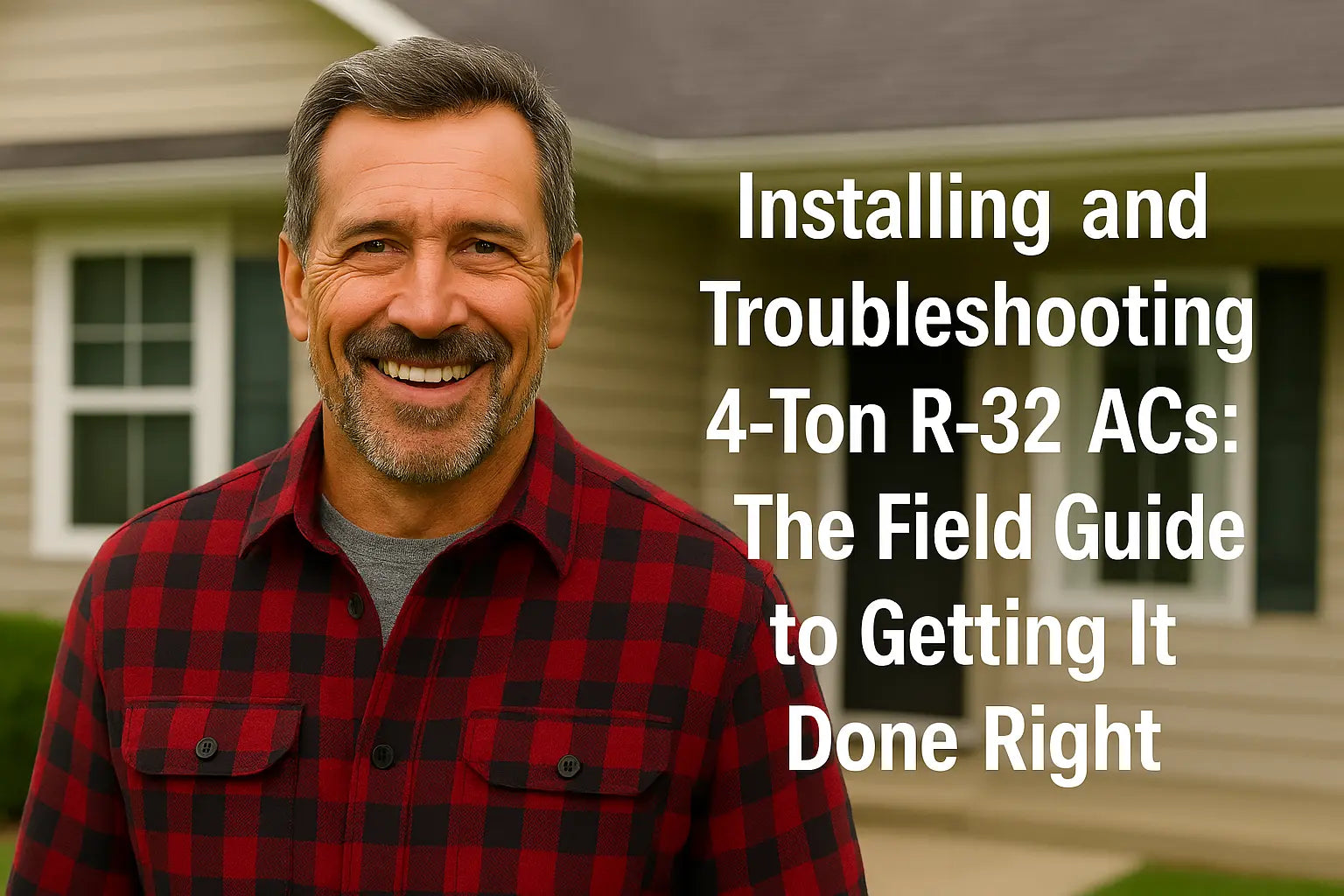Howdy, I’m Mike 👨🔧
If you're reading this, chances are you either just bought a 4-ton R-32 system (nice choice, by the way), or you're dealing with one that’s throwing fits. I’ve been in HVAC longer than I’ve owned a smartphone, and I’ve seen just about everything a unit can throw at you — leaks, low pressure, sensor errors, compressor drama — you name it. So today, we’re rolling up our sleeves and getting into the good stuff: how to install and troubleshoot a 4-ton R-32 residential AC system without losing your cool 😅
What Makes R-32 Different — and Why It Matters for Installation
Before you start dragging out your tools, let’s clear something up: R-32 isn’t just another refrigerant. It runs at higher pressure than R-410A, needs specific tools (especially for charging and recovery), and it’s mildly flammable — that’s an A2L rating.
If you’re new to R-32, check out this guide from the EPA on low-GWP refrigerants and A2L safety requirements. It's a must-read.
For installers, that means:
-
Proper ventilation is critical
-
You’ll need A2L-rated leak detectors
-
And torque wrenches? Non-negotiable. Over-tightening lines on an R-32 system = big problems.
Getting Started: What a Clean Install Looks Like
You want this thing running like a dream from day one. Here's what I always triple-check on a 4-ton R-32 install:
1. Suction and Liquid Line Sizing
For a 4-ton unit, your line sizing has to be spot-on. Too small and you choke the system. Too large and it won’t carry oil correctly.
I like this AC line sizing chart from Ferguson HVAC when I’m double-checking distances.
2. Refrigerant Charge
Your R-32 unit comes pre-charged, sure, but only for a certain line length — usually 15 feet. Measure twice, charge once.
Need help? HVAC School’s deep dive on charging techniques is golden — especially if you’re topping up.
3. Electrical Setup
Double-check that:
-
You’re on a dedicated 240V breaker
-
You’ve got properly rated disconnects
-
You’re grounding the unit correctly
A bad ground on an R-32 unit? That’s asking for premature failure — or worse.
Trouble in Paradise: Common R-32 Issues and Fixes
Even the best install can hit a snag later. Here are the ones I see most with 4-ton R-32 ACs, and how to fix 'em:
🧊 Issue: Unit Is Running But No Cooling
Cause: Refrigerant undercharge, kinked line set, or dirty indoor coil
Fix: Check charge using superheat/subcool method, inspect lines, and clean that coil. Don’t just eyeball — use a proper coil cleaner that’s R-32 compatible.
💥 Issue: System Trips the Breaker on Startup
Cause: Locked compressor or high inrush current
Fix: Test the run capacitor and check the compressor windings. Consider adding a soft-start kit if this keeps happening on a healthy unit.
💨 Issue: High Discharge Pressure
Cause: Blocked condenser coil or non-condensables in the system
Fix: Clean the coil. If pressure's still high, you might need to recover and recharge. Always purge with nitrogen before you vacuum!
Contractor Magazine explains why skipping that step is a recipe for bad readings.
Installation Checklist from the Field
Here’s the install checklist I actually use on 4-ton R-32 systems. Tape it to the wall, print it, tattoo it on your forearm — whatever works 😄
-
Line set sized and brazed correctly
-
Nitrogen purge during brazing
-
Pressure tested at 500 psi for 30 mins
-
Deep vacuum (500 microns or lower)
-
Line length confirmed for factory charge
-
Verified electrical connections and grounding
-
System started in cooling mode, charge dialed in
-
Supply/return temps within range
-
Customer walked through operation
Don’t skip the walkthrough — a customer who knows their system is less likely to blame you later when their nephew "tweaks" the thermostat.
Keeping Things Safe: R-32 Best Practices
Let’s talk safety — because R-32, while efficient and environmentally friendly, is still a mildly flammable refrigerant.
That means:
-
Never store or vent R-32 indoors
-
Use a UL-listed recovery machine rated for A2L
-
Train your crew (or yourself) on R-32 handling — AHRI has a solid training guide.
Also, make sure your state or local municipality allows residential R-32 installs. Most do now, but some still have local code quirks.
Final Checks and What to Watch Over Time
Even after a great install, things shift. I tell homeowners to keep an eye (and ear) on:
-
Weird noises — especially from the compressor
-
Unusual cycling — if it starts short cycling, you’ve got airflow or charge issues
-
Ice buildup — yep, even in the summer. That’s a red flag
Want a deeper dive on post-install inspections? Check out ASHRAE’s residential best practices for even more info.
Thinking of DIY? Mike’s Two Cents 🪙
Installing or troubleshooting a 4-ton AC isn’t beginner-level stuff. If you're comfortable with high-voltage wiring, brazing, and vacuum pumps — go for it, but always put safety first. If not? Get a licensed tech. Just make sure they’re familiar with R-32 systems. Not everyone is, and that’s where problems start.
From the Toolbox to the Thermostat: Mike’s Wrap-Up 🧰
So there you have it — your no-nonsense guide to installing and troubleshooting a 4-ton R-32 air conditioner. Whether you’re a handy homeowner or a seasoned tech, the key is staying sharp, following procedure, and never cutting corners. R-32’s efficient, lower-GWP, and built for the future — but like any new tech, it needs respect and know-how.
And hey, if you're still shopping or want to make sure you're getting the right system for your space, you can check out the 4-Ton R-32 AC units available here at The Furnace Outlet — they’ve got great deals, good specs, and support folks who know their stuff.
Curious about line sets for your 4-ton system? Visit my guide: The Right Line Set for Your 4-Ton R-32 AC.
Catch y’all on the next install 🧊
—Mike, your cool HVAC neighbor







